[English] 日本語
 Yorodumi
Yorodumi- PDB-7md5: Insulin receptor ectodomain dimer complexed with two IRPA-9 parti... -
+ Open data
Open data
- Basic information
Basic information
| Entry | Database: PDB / ID: 7md5 | ||||||
|---|---|---|---|---|---|---|---|
| Title | Insulin receptor ectodomain dimer complexed with two IRPA-9 partial agonists | ||||||
 Components Components |
| ||||||
 Keywords Keywords | PEPTIDE BINDING PROTEIN / Insulin receptor | ||||||
| Function / homology |  Function and homology information Function and homology informationregulation of female gonad development / positive regulation of meiotic cell cycle / insulin-like growth factor II binding / positive regulation of developmental growth / insulin receptor complex / male sex determination / positive regulation of protein-containing complex disassembly / insulin-like growth factor I binding / exocrine pancreas development / dendritic spine maintenance ...regulation of female gonad development / positive regulation of meiotic cell cycle / insulin-like growth factor II binding / positive regulation of developmental growth / insulin receptor complex / male sex determination / positive regulation of protein-containing complex disassembly / insulin-like growth factor I binding / exocrine pancreas development / dendritic spine maintenance / cargo receptor activity / insulin binding / negative regulation of NAD(P)H oxidase activity / adrenal gland development / neuronal cell body membrane / negative regulation of glycogen catabolic process / PTB domain binding / negative regulation of feeding behavior / positive regulation of nitric oxide mediated signal transduction / negative regulation of fatty acid metabolic process / Signaling by Insulin receptor / IRS activation / Insulin processing / regulation of protein secretion / positive regulation of peptide hormone secretion / positive regulation of protein autophosphorylation / Regulation of gene expression in beta cells / positive regulation of respiratory burst / amyloid-beta clearance / negative regulation of acute inflammatory response / regulation of embryonic development / alpha-beta T cell activation / positive regulation of receptor internalization / insulin receptor substrate binding / protein kinase activator activity / positive regulation of dendritic spine maintenance / Synthesis, secretion, and deacylation of Ghrelin / negative regulation of respiratory burst involved in inflammatory response / positive regulation of insulin receptor signaling pathway / epidermis development / negative regulation of protein secretion / activation of protein kinase B activity / negative regulation of gluconeogenesis / positive regulation of glycogen biosynthetic process / fatty acid homeostasis / Signal attenuation / FOXO-mediated transcription of oxidative stress, metabolic and neuronal genes / negative regulation of lipid catabolic process / positive regulation of lipid biosynthetic process / regulation of protein localization to plasma membrane / transport across blood-brain barrier / heart morphogenesis / negative regulation of oxidative stress-induced intrinsic apoptotic signaling pathway / phosphatidylinositol 3-kinase binding / transport vesicle / nitric oxide-cGMP-mediated signaling / COPI-mediated anterograde transport / positive regulation of nitric-oxide synthase activity / Insulin receptor recycling / negative regulation of reactive oxygen species biosynthetic process / insulin-like growth factor receptor binding / positive regulation of brown fat cell differentiation / NPAS4 regulates expression of target genes / neuron projection maintenance / endoplasmic reticulum-Golgi intermediate compartment membrane / dendrite membrane / positive regulation of mitotic nuclear division / Insulin receptor signalling cascade / insulin receptor activity / regulation of transmembrane transporter activity / receptor-mediated endocytosis / learning / positive regulation of glycolytic process / positive regulation of cytokine production / positive regulation of long-term synaptic potentiation / endosome lumen / acute-phase response / positive regulation of protein secretion / positive regulation of D-glucose import / insulin receptor binding / positive regulation of cell differentiation / Regulation of insulin secretion / wound healing / receptor protein-tyrosine kinase / negative regulation of protein catabolic process / hormone activity / regulation of synaptic plasticity / positive regulation of neuron projection development / cellular response to growth factor stimulus / receptor internalization / caveola / memory / positive regulation of protein localization to nucleus / Golgi lumen / cognition / cellular response to insulin stimulus / glucose metabolic process / male gonad development / positive regulation of nitric oxide biosynthetic process / vasodilation Similarity search - Function | ||||||
| Biological species |  Homo sapiens (human) Homo sapiens (human) | ||||||
| Method | ELECTRON MICROSCOPY / single particle reconstruction / cryo EM / Resolution: 5.2 Å | ||||||
 Authors Authors | Gomez-Llorente, Y. / Zhou, H. / Scapin, G. | ||||||
 Citation Citation |  Journal: Nat Commun / Year: 2022 Journal: Nat Commun / Year: 2022Title: Functionally selective signaling and broad metabolic benefits by novel insulin receptor partial agonists. Authors: Margaret Wu / Ester Carballo-Jane / Haihong Zhou / Peter Zafian / Ge Dai / Mindy Liu / Julie Lao / Terri Kelly / Dan Shao / Judith Gorski / Dmitri Pissarnitski / Ahmet Kekec / Ying Chen / ...Authors: Margaret Wu / Ester Carballo-Jane / Haihong Zhou / Peter Zafian / Ge Dai / Mindy Liu / Julie Lao / Terri Kelly / Dan Shao / Judith Gorski / Dmitri Pissarnitski / Ahmet Kekec / Ying Chen / Stephen F Previs / Giovanna Scapin / Yacob Gomez-Llorente / Scott A Hollingsworth / Lin Yan / Danqing Feng / Pei Huo / Geoffrey Walford / Mark D Erion / David E Kelley / Songnian Lin / James Mu /  Abstract: Insulin analogs have been developed to treat diabetes with focus primarily on improving the time action profile without affecting ligand-receptor interaction or functional selectivity. As a result, ...Insulin analogs have been developed to treat diabetes with focus primarily on improving the time action profile without affecting ligand-receptor interaction or functional selectivity. As a result, inherent liabilities (e.g. hypoglycemia) of injectable insulin continue to limit the true therapeutic potential of related agents. Insulin dimers were synthesized to investigate whether partial agonism of the insulin receptor (IR) tyrosine kinase is achievable, and to explore the potential for tissue-selective systemic insulin pharmacology. The insulin dimers induced distinct IR conformational changes compared to native monomeric insulin and substrate phosphorylation assays demonstrated partial agonism. Structurally distinct dimers with differences in conjugation sites and linkers were prepared to deliver desirable IR partial agonist (IRPA). Systemic infusions of a B29-B29 dimer in vivo revealed sharp differences compared to native insulin. Suppression of hepatic glucose production and lipolysis were like that attained with regular insulin, albeit with a distinctly shallower dose-response. In contrast, there was highly attenuated stimulation of glucose uptake into muscle. Mechanistic studies indicated that IRPAs exploit tissue differences in receptor density and have additional distinctions pertaining to drug clearance and distribution. The hepato-adipose selective action of IRPAs is a potentially safer approach for treatment of diabetes. | ||||||
| History |
|
- Structure visualization
Structure visualization
| Movie |
 Movie viewer Movie viewer |
|---|---|
| Structure viewer | Molecule:  Molmil Molmil Jmol/JSmol Jmol/JSmol |
- Downloads & links
Downloads & links
- Download
Download
| PDBx/mmCIF format |  7md5.cif.gz 7md5.cif.gz | 301.2 KB | Display |  PDBx/mmCIF format PDBx/mmCIF format |
|---|---|---|---|---|
| PDB format |  pdb7md5.ent.gz pdb7md5.ent.gz | 237.8 KB | Display |  PDB format PDB format |
| PDBx/mmJSON format |  7md5.json.gz 7md5.json.gz | Tree view |  PDBx/mmJSON format PDBx/mmJSON format | |
| Others |  Other downloads Other downloads |
-Validation report
| Summary document |  7md5_validation.pdf.gz 7md5_validation.pdf.gz | 2.1 MB | Display |  wwPDB validaton report wwPDB validaton report |
|---|---|---|---|---|
| Full document |  7md5_full_validation.pdf.gz 7md5_full_validation.pdf.gz | 2.1 MB | Display | |
| Data in XML |  7md5_validation.xml.gz 7md5_validation.xml.gz | 54.2 KB | Display | |
| Data in CIF |  7md5_validation.cif.gz 7md5_validation.cif.gz | 79.1 KB | Display | |
| Arichive directory |  https://data.pdbj.org/pub/pdb/validation_reports/md/7md5 https://data.pdbj.org/pub/pdb/validation_reports/md/7md5 ftp://data.pdbj.org/pub/pdb/validation_reports/md/7md5 ftp://data.pdbj.org/pub/pdb/validation_reports/md/7md5 | HTTPS FTP |
-Related structure data
| Related structure data |  23767MC  7md4C M: map data used to model this data C: citing same article ( |
|---|---|
| Similar structure data |
- Links
Links
- Assembly
Assembly
| Deposited unit | 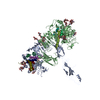
|
|---|---|
| 1 |
|
- Components
Components
-Isoform Short of Insulin ... , 2 types, 4 molecules ABMN
| #1: Protein | Mass: 106143.359 Da / Num. of mol.: 2 / Fragment: extracellular domain Source method: isolated from a genetically manipulated source Source: (gene. exp.)  Homo sapiens (human) / Gene: INSR / Cell line (production host): Myeloma / Production host: Homo sapiens (human) / Gene: INSR / Cell line (production host): Myeloma / Production host:  References: UniProt: P06213, receptor protein-tyrosine kinase #2: Protein/peptide | Mass: 3459.836 Da / Num. of mol.: 2 / Fragment: C-terminal helix Source method: isolated from a genetically manipulated source Source: (gene. exp.)  Homo sapiens (human) / Gene: INSR / Cell line (production host): Myeloma / Production host: Homo sapiens (human) / Gene: INSR / Cell line (production host): Myeloma / Production host:  References: UniProt: P06213, receptor protein-tyrosine kinase |
|---|
-Protein/peptide , 2 types, 8 molecules SOQUTPRV
| #3: Protein/peptide | Mass: 2383.698 Da / Num. of mol.: 4 Source method: isolated from a genetically manipulated source Source: (gene. exp.)  Homo sapiens (human) / Gene: INS / Production host: Homo sapiens (human) / Gene: INS / Production host:  #4: Protein/peptide | Mass: 3433.953 Da / Num. of mol.: 4 Source method: isolated from a genetically manipulated source Source: (gene. exp.)  Homo sapiens (human) / Gene: INS / Production host: Homo sapiens (human) / Gene: INS / Production host:  |
|---|
-Sugars , 5 types, 14 molecules 
| #5: Polysaccharide | 2-acetamido-2-deoxy-beta-D-glucopyranose-(1-4)-[alpha-L-fucopyranose-(1-6)]2-acetamido-2-deoxy-beta- ...2-acetamido-2-deoxy-beta-D-glucopyranose-(1-4)-[alpha-L-fucopyranose-(1-6)]2-acetamido-2-deoxy-beta-D-glucopyranose Source method: isolated from a genetically manipulated source #6: Polysaccharide | Source method: isolated from a genetically manipulated source #7: Polysaccharide | Source method: isolated from a genetically manipulated source #8: Polysaccharide | Source method: isolated from a genetically manipulated source #9: Sugar | ChemComp-NAG / |
|---|
-Details
| Has ligand of interest | N |
|---|---|
| Has protein modification | Y |
-Experimental details
-Experiment
| Experiment | Method: ELECTRON MICROSCOPY |
|---|---|
| EM experiment | Aggregation state: PARTICLE / 3D reconstruction method: single particle reconstruction |
- Sample preparation
Sample preparation
| Component |
| ||||||||||||||||||||||||
|---|---|---|---|---|---|---|---|---|---|---|---|---|---|---|---|---|---|---|---|---|---|---|---|---|---|
| Molecular weight | Value: 0.23 MDa / Experimental value: YES | ||||||||||||||||||||||||
| Source (natural) |
| ||||||||||||||||||||||||
| Source (recombinant) |
| ||||||||||||||||||||||||
| Buffer solution | pH: 7.4 | ||||||||||||||||||||||||
| Specimen | Embedding applied: NO / Shadowing applied: NO / Staining applied: NO / Vitrification applied: YES | ||||||||||||||||||||||||
| Specimen support | Grid material: COPPER / Grid type: Homemade | ||||||||||||||||||||||||
| Vitrification | Cryogen name: ETHANE |
- Electron microscopy imaging
Electron microscopy imaging
| Experimental equipment |  Model: Titan Krios / Image courtesy: FEI Company |
|---|---|
| Microscopy | Model: FEI TITAN KRIOS |
| Electron gun | Electron source:  FIELD EMISSION GUN / Accelerating voltage: 300 kV / Illumination mode: FLOOD BEAM FIELD EMISSION GUN / Accelerating voltage: 300 kV / Illumination mode: FLOOD BEAM |
| Electron lens | Mode: BRIGHT FIELD / Cs: 2.7 mm / Alignment procedure: COMA FREE |
| Specimen holder | Cryogen: NITROGEN / Specimen holder model: FEI TITAN KRIOS AUTOGRID HOLDER |
| Image recording | Electron dose: 45 e/Å2 / Detector mode: COUNTING / Film or detector model: GATAN K2 SUMMIT (4k x 4k) |
- Processing
Processing
| EM software | Name: Leginon / Category: image acquisition |
|---|---|
| CTF correction | Type: PHASE FLIPPING AND AMPLITUDE CORRECTION |
| 3D reconstruction | Resolution: 5.2 Å / Resolution method: FSC 0.143 CUT-OFF / Num. of particles: 54293 / Symmetry type: POINT |
 Movie
Movie Controller
Controller



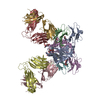

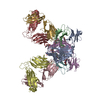

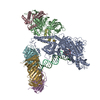
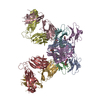

 PDBj
PDBj






















